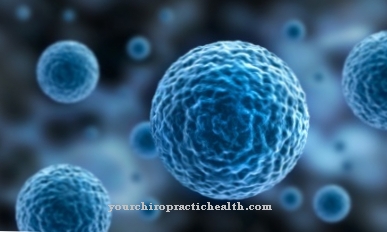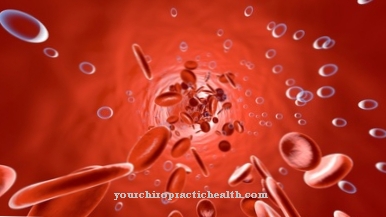Under the umbrella term Wrinkling the doctor understands the aging of the skin and the associated development of wrinkles. The formation of wrinkles is due to different causes and is different for every person. The process of wrinkling begins around the age of 25. The process cannot be stopped. However, various measures can slow down the formation of wrinkles. Not least because of its importance for the cosmetics industry, there are countless areas of research that investigate wrinkle formation and how to combat it.
What is wrinkling?

The general term "wrinkling" summarizes the skin's natural aging process. Wrinkle formation begins around the mid-20s in a person's life. It progresses throughout life and is only completed with death.
When the wrinkles begin to form, the wrinkles can hardly be seen with the naked eye, but as the wrinkle formation continues, the wrinkles become clearly visible. The areas of skin around the eyes, on the forehead and in the area of the mouth and nose in particular tend to develop deep wrinkles. Around the middle / end of the 40s, wrinkles are clearly visible. Mostly around the age of 40 people notice the first wrinkles themselves.
The formation of wrinkles is due to intrinsic and extrinsic factors. The genetic conditions are meant by intrinsic factors. In the genes it is not only stipulated when the formation of wrinkles begins, it is also laid down in what form and at what speed the formation of wrinkles progresses. Under extrinsic factors are to be understood environmental influences. Environmental factors that influence the formation of wrinkles are, for example, heat, cold or UV radiation.
Function & task
The formation of wrinkles is due on the one hand to intrinsic and on the other hand to extrinsic factors. On the intrinsic factors, i.e. humans have no influence on genetic predisposition. Wrinkles begin to form around the middle of the twentieth year, namely in the area of the outer skin layer (dermis). The dermis is made up of connective tissue cells and fibers. The connective tissue fibers collagen (ensures stability) and elastin (ensures elasticity) are less and less formed with increasing age.
In addition, the subcutaneous fat layer is broken down more and more; deep wrinkles on the dermis are the result. The process is triggered by the increase in the protein transcription factor NF-kappa B.
Humans can partially influence the extrinsic factors. If the skin is exposed to more UV radiation, the formation of wrinkles not only begins earlier, it also progresses faster. The following circumstance is responsible for this: The UV-A radiation penetrates deep into the skin and releases free radicals and singlet oxygen. Free radicals and the singlet oxygen ensure the destruction of elastin and collagen - the immediate result is increased wrinkling.
Dermatologists therefore recommend only exposing the skin to a small amount of UV radiation and using a cream with a high sun protection factor.
If the skin is exposed to excessive heat or cold, this also has a direct impact on the formation of wrinkles. The finest cracks and scars promote the formation of wrinkles. Here, too, dermatologists recommend protecting the skin from the influences.
From a medical point of view, wrinkling does not fulfill any tasks. Nevertheless, the formation of wrinkles seems to make sense. The age of a person can be estimated quickly and accurately from the skin or the depth of the wrinkles. Psychologists agree that the formation of wrinkles therefore fulfills an important task in the context of group dynamic processes. The principle of seniority makes it easier for the younger people in a group to find their way around and offers protection.
This benefit of wrinkling, interpreted more in terms of psychological dynamics, is currently the subject of corresponding research. Whether there is also a medical benefit is currently controversial. The release of the protein transcription factor NF-kappa B fulfills other functions in the human body; the triggering of wrinkles is only a side effect. Research aimed at preventing or inhibiting the release of the protein is already underway. However, it is currently uncertain whether an active ingredient can be found that can stop the formation of wrinkles by inhibiting the enzyme.
Illnesses & ailments
The formation of wrinkles itself does not cause discomfort or illness. Nevertheless, women in particular suffer from the formation of wrinkles. A youth cult prevails in today's society. Young people are said to have mostly positive characteristics such as productivity and willingness to perform, while older people tend to assume poor performance and lack of motivation.
In addition, today's ideal of beauty is more oriented towards youthfulness. Many people therefore suffer psychologically from the formation of wrinkles. Particularly affected by psychosomatic complaints that have been triggered by wrinkling are people who tend to develop more wrinkles at a young age. Direct consequences are not infrequently the constant preoccupation with the aging processes and the attempt to prevent them through various cosmetic or surgical interventions. Some sufferers develop depression because of their best efforts to prevent wrinkles from forming.
Overall, and this is the tragic thing about the perceived psychological stress caused by wrinkles and aging, these beauty norms are solely culturally determined and thus a self-made problem. If this is recognized and seen through, on the other hand, it also opens up the possibility to distance yourself from this social norm and thereby escape the pressure of beauty and youth, which ultimately have no qualitative value.
If the formation of wrinkles begins very early in a person's life and the wrinkles are very deep, a dermatologist should be consulted. The unusual wrinkling can be an indication of deeper damage in the skin, such as triggered by the strong exposure to UV light. The doctor will work with the patient to determine how the damage to the skin can be treated.













.jpg)

.jpg)
.jpg)











.jpg)